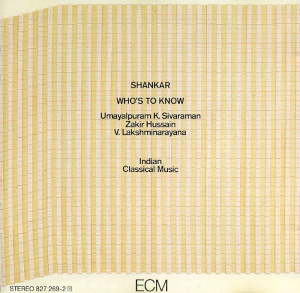
Ustad Zakir Hussain is an Indian tabla player, composer, percussionist, music producer and film actor. He is the eldest son of tabla player Alla Rakha. He is widely considered as one of the greatest tabla players of all time.

John McLaughlin, also known as Mahavishnu, is an English guitarist, bandleader, and composer. A pioneer of jazz fusion, his music combines elements of jazz with rock, world music, Western classical music, flamenco, and blues. After contributing to several key British groups of the early 1960s, McLaughlin made Extrapolation, his first album as a bandleader, in 1969. He then moved to the U.S., where he played with drummer Tony Williams's group Lifetime and then with Miles Davis on his electric jazz fusion albums In a Silent Way, Bitches Brew, Jack Johnson, Live-Evil, and On the Corner. His 1970s electric band, the Mahavishnu Orchestra, performed a technically virtuosic and complex style of music that fused electric jazz and rock with Indian influences.

Uppalapu Srinivas was an Indian mandolin player in Carnatic classical music and composer. Because he was a child prodigy, he was sometimes called the Mozart of classical Indian music.

Subramaniam Lakshminarayana is an Indian violinist, composer and conductor, trained in the classical Carnatic music tradition and Western classical music.

Shakti is a fusion band formed by English guitarist John McLaughlin, Indian violin player L. Shankar, percussionists Zakir Hussain and T. H. "Vikku" Vinayakram in 1973, initially under the stage name "Turiyananda Sangit". The band played acoustic fusion music which combined Indian music with elements of jazz. The band's name means, in English, "creative intelligence, beauty, and power."
Indo jazz is a musical genre consisting of jazz, classical and Indian influences. Its structure and patterns are based on Indian music with typical jazz improvisation overlaid. While the term itself may be comparatively recent, the concept dates at least to the mid-1950s. Musicians including John Coltrane, Yusef Lateef and others reflect Indian influences.
Remember Shakti is a quintet which combines elements of traditional Indian music with elements of jazz. The band consists of English guitarist John McLaughlin, and Zakir Hussain (tabla), U. Srinivas (deceased) (mandolin), Shankar Mahadevan (vocals), and V. Selvaganesh, who are of Indian descent. The band's name is derived from John Mclaughlin's acoustic Indian fusion band Shakti which was active in the 1970s. McLaughlin and Hussain were also members of that band, along with violinist L. Shankar and percussionists T.H. "Vikku" Vinayakram and R. Raghavan. The word Shakti translates in Sanskrit to "power" or "goddess of power".

Lakshmi Shankar was an Indian singer and a noted Hindustani classical. Born into a south Indian Hindu family, she became an outstanding Hindustani vocalist of the Patiala Gharana and married Rajendra Shankar, brother of Uday Shankar, a Bengali by birth. She was known for her performances of khyal, thumri, and bhajan. She was the sister-in-law of sitar player Ravi Shankar and the mother-in-law of violinist L. Subramaniam.

Thetakudi Harihara Vinayakram, also known as Vikku Vinayakram, is an Indian percussionist. He is also known as the God of ghatam. He plays Carnatic music with the ghatam, an earthen pot, and is credited with popularising the ghatam.
L. Shankar has served as an instrumentalist, composer, record producer, arranger and programmer on several recordings. He has released a number of his own recordings, in addition to appearing on other artists' albums. All credits are for violin, except where noted. This is not an exhaustive list of Shankar's works, but a select few titles.

Natural Elements is a studio album by the world fusion band Shakti. It was released in 1977 on CBS Records.

A Handful of Beauty is the first studio album released by the world fusion band Shakti in 1976.

Who's to Know is the second studio album by violinist Shankar, recorded in November 1980 and released on ECM the following year. The trio features percussionists Umayalpuram K. Sivaraman and Zakir Hussain.

Shankar Tucker is an American clarinetist and music composer. He rose to fame with the popularity of his YouTube music channel "The ShrutiBox".

Remember Shakti is a live album by the world fusion band Remember Shakti recorded in England over four nights, and released in 1999 on the Verve label. The reformed group features original members John McLaughlin (guitar), Zakir Hussain (tabla) and Vikku Vinayakram (ghatam), who are joined by Hariprasad Chaurasia on the bansuri. The album reached number 14 in the Billboard Top Jazz albums chart.

Remember Shakti – The Believer is a live album by the world fusion band Remember Shakti, that was released in 2000 on the Verve label. The live set features John McLaughlin on guitar, electric mandolinist U. Srinivas, Vikku Selvaganesh playing ghatam, and tabla player Zakir Hussain. The album peaked number 20 in the Billboard Top Jazz Albums chart.

Remember Shakti – Saturday Night in Bombay is a live album by the world fusion band Remember Shakti released in November 2001 on the Verve label. This concert features John McLaughlin on guitar, U. Srinivas on electric mandolin, Vikku Selvaganesh on ghatam, kanjira and mridangam, Zakir Hussain on tabla and a number of guest musicians, including vocalist Shankar Mahadeven, slide guitarist Debashish Bhattacharya and drummer Sivamani.
George Brooks is an American saxophonist known for combining jazz and Indian classical music. He is the founder of the jazz fusion groups Summit, Aspada, Bombay Jazz, the Raga Bop Trio, and Elements.

Raga Aberi is an album by the Indian musician L. Shankar, released in 1995. He is credited with Zakir Hussain and Vikku Vinayakram.


























